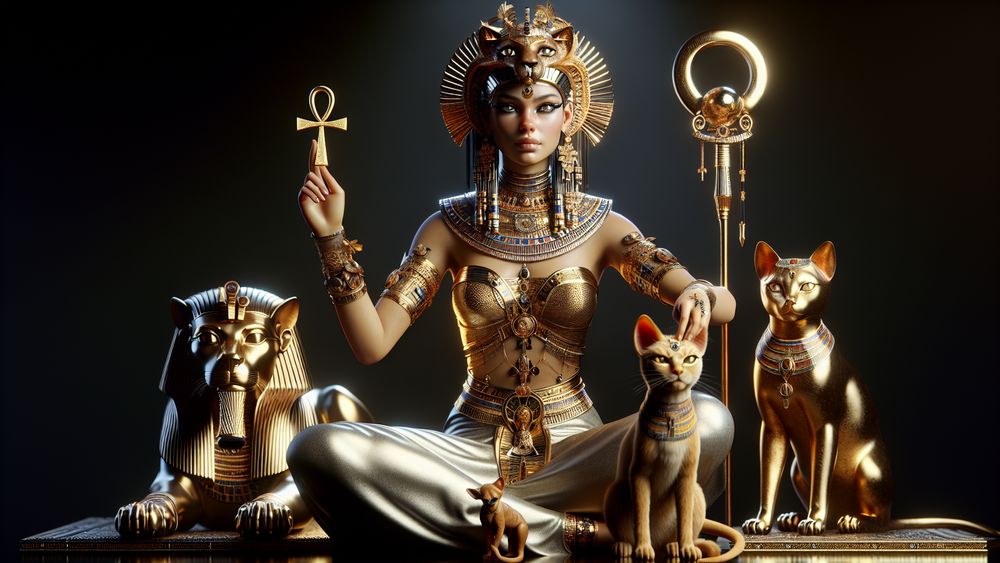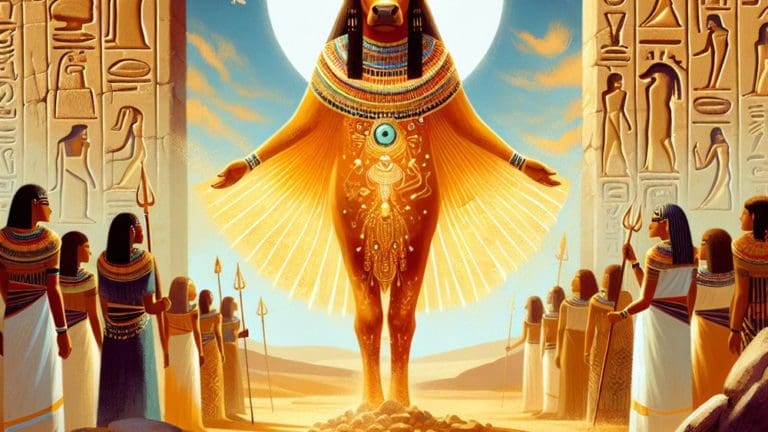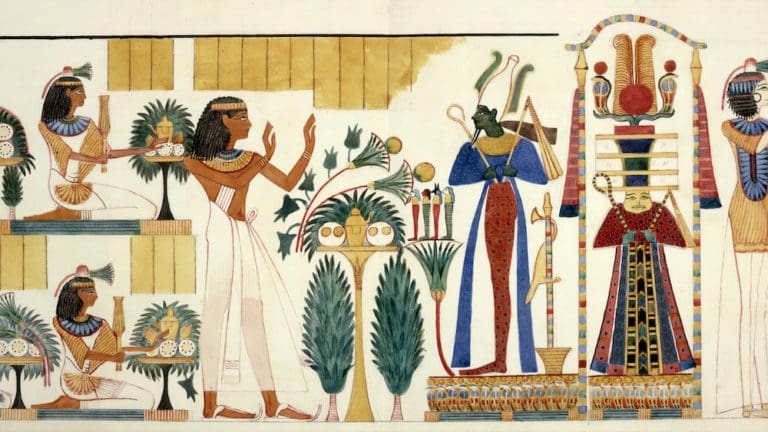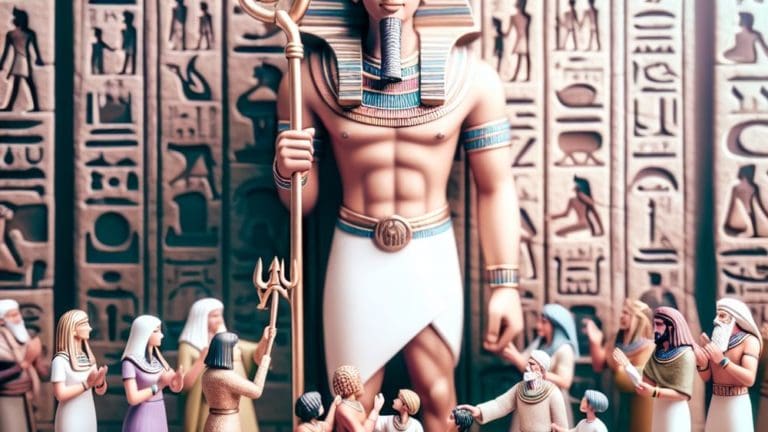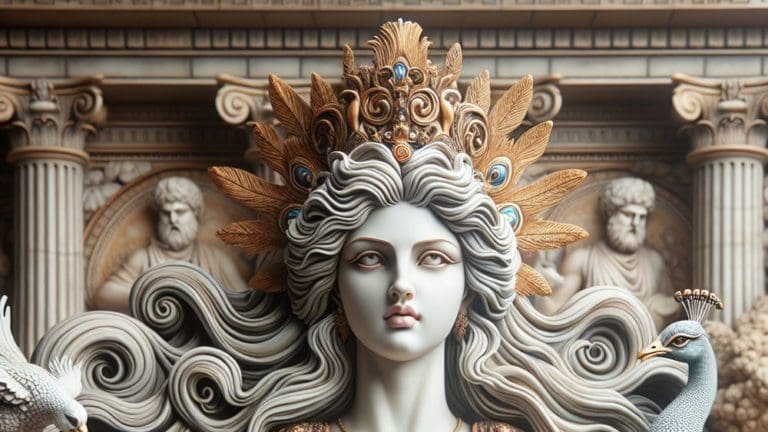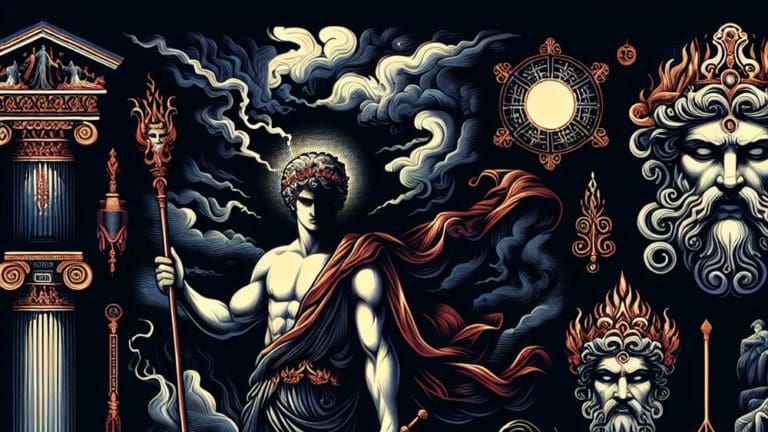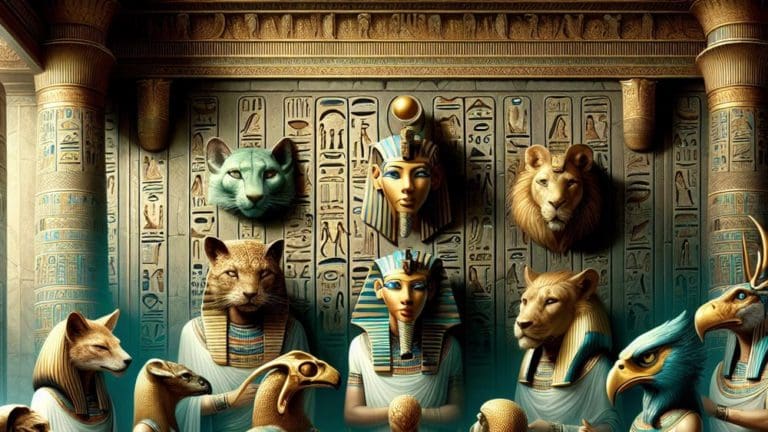Bastet: Egyptian Goddess Of Love, Cats, And War
The world of Egyptian gods and goddesses is full and complex. Bastet is a key example of this. She started as a fierce lioness, a warrior and protector. Over time, people began to see her more like a gentle house cat. She came to symbolize fertility and being a mother.
Key Points:
- Bastet evolved from a lioness warrior to a domestic cat, reflecting changing societal needs and values.
- Bastet symbolizes love, fertility, protection, and strength in Egyptian mythology.
- Key symbols linked to Bastet include the sistrum and the domestic cat.
- Bastet’s festivals and rituals celebrate her various roles and seek her favor for safety and fertility.
- Bastet is represented in modern culture and media as a symbol of femininity and strength.
- Art and literature often revisit Bastet’s story, portraying her as a caring yet protective deity.
- Egyptian mythology features a pantheon of gods and goddesses, each with unique roles and stories that reflect societal values and beliefs.
This change tells us how the beliefs and needs of people in ancient Egypt shifted over time. They adapted their gods to fit new understandings and situations. Bastet’s worship went on for thousands of years.
This made her a very important and loved figure in Egyptian mythology. Her story and symbols are still with us, which says a lot about her impact on ancient Egyptian culture and art.
The Origin and History of Bastet
To really get why Bastet matters so much, we need to look closely at where she comes from and how she grew over time.
From Fierce Lioness to Benevolent Protector
At first, people saw Bastet as a big and strong lioness. This showed she was a guard and fighter for them. Being a lioness meant she was tough and ready to battle for the pharaoh and the country.
Yet, as time went on and what people needed changed, so did Bastet’s image. She became a small and gentle house cat. This new look put the spotlight on her caring and guarding side. It matched how folks started to value family and home more and more.
Moving from a lioness to a house cat also showed a bigger change in Egyptian beliefs. They started to prefer gods that could keep their homes and loved ones safe.
People’s perception of Bastet shifted from a strong lioness to a gentle house cat, reflecting changing values towards family and home security.
Goddess of Love and Fertility
Bastet changed a lot over time. She went from being a strong fighter to someone who cares and protects. People started to see her as a goddess who brings love and helps families grow.
She became very popular for helping with having babies and making sure they are born healthy. This was super important for people in ancient Egypt because they really cared about having a strong family line. Bastet’s signs, like the sistrum and cats, show her gentle side but also how she protects.

The sistrum is a kind of music maker that people thought could bring happiness and help women get pregnant. Cats, which have lots of babies and take good care of them, were seen as mini versions of Bastet. They showed how she looks after people and their homes.
So, Bastet got famous for being the goddess who looks after love and families. People wanted her help to make their homes happy and full of love. They wore amulets with her image and kept figures of cats to remind them of her.
This way, Bastet became a key part of their lives, especially when it came to matters of the heart and home.
Protector and War Deity
Bastet was more than a goddess of love and babies. She was also a strong protector and war deity. In her early days, people saw her as a lioness. This showed she was very strong and could fight well.
Even when her image changed to a gentle cat, she kept her role as a protector. She looked after homes and families very well. One way Bastet protected people was by being the Eye of Ra. This meant she worked for the sun god Ra. She fought against bad forces and kept everything in balance.
Her job was very important for keeping peace and order in the world. People went to her temples for help and protection. The city of Bubastis was especially famous for worship of Bastet. It had big celebrations for her.
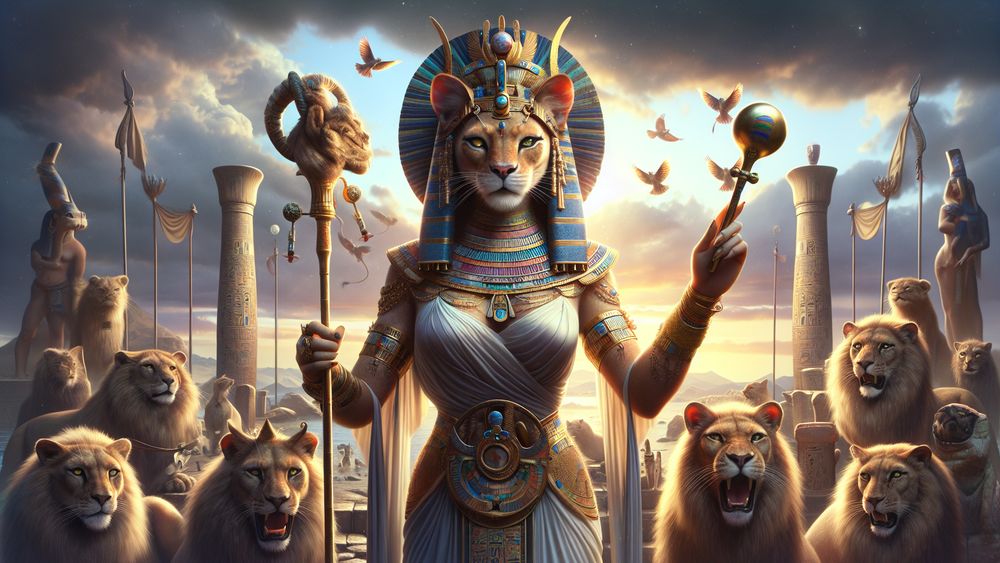
These events showed how much people respected and needed her for both love and protection. When people wanted Bastet’s protection, they used amulets and statues that showed her image. They thought these items had her power and could keep them safe. This belief was very strong, especially when there was war or trouble.
So, while Bastet may have looked different over time, her main job as a guardian and warrior stayed the same. People always saw her as a powerful and caring goddess.
Bastet, a multi-faceted deity, was recognized for her strength as a protector and warrior while maintaining her role as a guardian and caretaker throughout history.
Symbols and Representations of Bastet
When we talk about Bastet, we see a lot of symbols and images that tell us about her. These symbols help us get what she means to people. We’re going to look at these so we can really understand her role and importance. Bastet has many symbols that show who she is.
The Sistrum and Its Significance
The sistrum is a kind of musical tool that people in ancient Egypt used a lot when they showed their love for Bastet. Picture a metal instrument with a handle and a U-shape at the top. It has bars that move and make noise when you shake it. This noise was very special because people thought it could keep away bad spirits and bring in good ones. Let’s break down why the sistrum was so key for Bastet:
- Brings happiness: People used it during parties and special times that were all for Bastet. It made everyone feel good and full of joy.
- Helps with babies and growing families: Since Bastet cared a lot about mothers and their children, the sistrum’s sound was also a sign of wishing for more children and healthy births.
- Keeps you safe: The idea was that the sound it made would scare off anything bad. This links back to Bastet watching over everyone.
- Tied to music and moving: It was a big part of the music and dancing that went on when people came together to honor Bastet.
So, the sistrum wasn’t simply an instrument. It stood for so much of what Bastet meant to people. It was about being happy, safe, and hoping for a family. It showed how Bastet could bring joy and protection.
This makes it very clear why the sistrum was so tied to her and why people valued it so much in their celebrations and daily lives.
Iconography and Animal Associations
When we talk about Bastet and the symbols and animals that represent her, we’re getting into the heart of what she means to people. These symbols and animals are like clues that help us understand her better.
Let’s look at a simple table that breaks down the main ones and tells us why they’re so key.
| Symbol/Animal | Significance |
|---|---|
| Cat | The cat is all about how Bastet can be both gentle and tough when she needs to be. Cats take really good care of their babies but can also defend them bravely. This fits with Bastet being seen as a caring mother and a protector. |
| Lioness | The lioness takes us back to when Bastet was more about strength and fighting. A lioness is very strong and fearless, which were seen as Bastet’s qualities in the old days before she became more gentle. |
| Sistrum | This is a musical tool that was played to honor Bastet. It’s linked to happiness and keeping away bad vibes because of its sound. It connects to Bastet’s role in bringing joy and safety. |
These symbols and animals make it easier for us to get who Bastet was and what she stood for. They show her as someone who could be both loving and strong, which was very special to the people who looked up to her.
By using these symbols, they could keep her close in their daily lives and remember all the good she could do for them. It’s a smart way to keep the memory and power of Bastet alive and well for everyone who cared about her.
Worship and Cult of Bastet
When we talk about how people showed love for Bastet, we’re really getting into the heart of their community and beliefs. They had a special way of coming together to honor her.
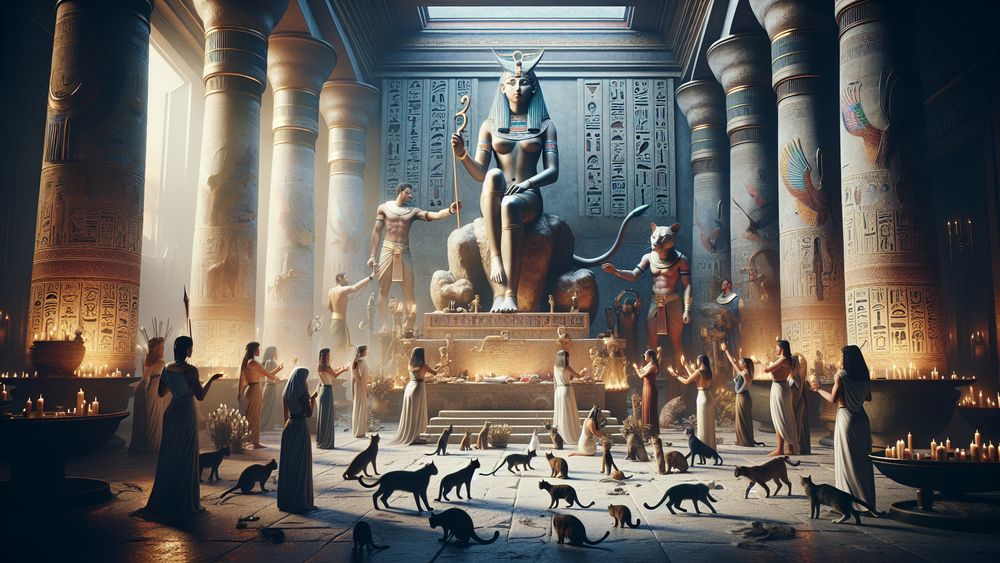
Major Temples and Sacred Sites
In the Nile Delta, there’s a place called Bubastis which was very special for people who loved Bastet. They built a big temple for her there. This place was different because it had lovely gardens and buildings which you don’t see much in other Egyptian temples.
It showed that Bastet was about more than being strong; she was also about making life and homes better. People from all over came to Bubastis, especially when there was a festival for Bastet. It was a time for fun and to show respect for her. There was another temple in a place called Leontopolis.
This one also showed Bastet as a lioness which is how people first knew her before they started to think of her more like a house cat. Even though Bubastis was where most people went for Bastet, Leontopolis was still an essential place for her followers. These temples were very busy spots.
They weren’t simply for praying. People met there for celebrations and to feel part of a bigger community. Inside, you could find statues and pictures of Bastet which helped everyone remember how she could be both gentle and protective. These places remind us that Bastet was very special for ancient Egyptians, helping them feel safe and happy.
Bubastis and Leontopolis were key temples for followers of Bastet, where people gathered for festivals and community celebrations, emphasizing the multifaceted nature of the goddess and her importance in ancient Egyptian society.
Festivals and Celebrations
When people showed their love for Bastet, they really went all out. The biggest event for her was the Festival of Bubastis. This was a huge party that brought people from all over Egypt together. Let’s break down what made these festivals so special:
- Processions: Imagine a long line of people walking through the streets. They carried statues of Bastet, which was their way of saying thank you and asking for her protection. It was a sight that brought everyone closer.
- Music and Dancing: Since Bastet liked the sistrum, music and dancing were a must. The sound of this instrument was key. People thought it made Bastet happy and would bring them good luck.
- River Journeys: Lots of folks took boats to get to the festival. These trips were like mini-parties on the water. There was lots of singing and dancing on the way.
- Sacrifices and Offerings: People brought gifts for Bastet. These could be food or other nice items. It was their way of giving something back to her for all her help.
- Feasting and Merrymaking: Besides all the serious parts, these festivals were also about having a good time. People ate, laughed, and enjoyed each other’s company. It was a chance to relax and feel happy.
These festivals did more than honor Bastet. They helped people feel like they were part of a bigger family. Everyone came together, which made their community stronger and happier.
Bastet in Modern Culture
Today, Bastet still makes her mark. We find her in books, movies, and art. She’s more than an ancient figure; she’s a part of our world now. Let’s look at how she fits into today’s scene. Bastet, from ancient Egypt, has a story that reaches us today. She appears in many places in our culture.
The Goddess in Contemporary Media and Pop Culture
Today, we see Bastet in many places outside of history books. She appears in video games, TV, movies, and even comics. Each time, she brings something special from her story to ours. Let’s break this down simply and clearly. In video games, Bastet often becomes a character we can play or meet. These games show her as having special skills.
These skills might help heal friends or control the area to keep everyone safe. This directly links back to her old roles as a protector and a giver of life.
When it comes to TV and movies, Bastet might pop up in stories about gods and myths. A show might have an episode that tells us about her. It would talk about how she can be both loving and ready for battle.
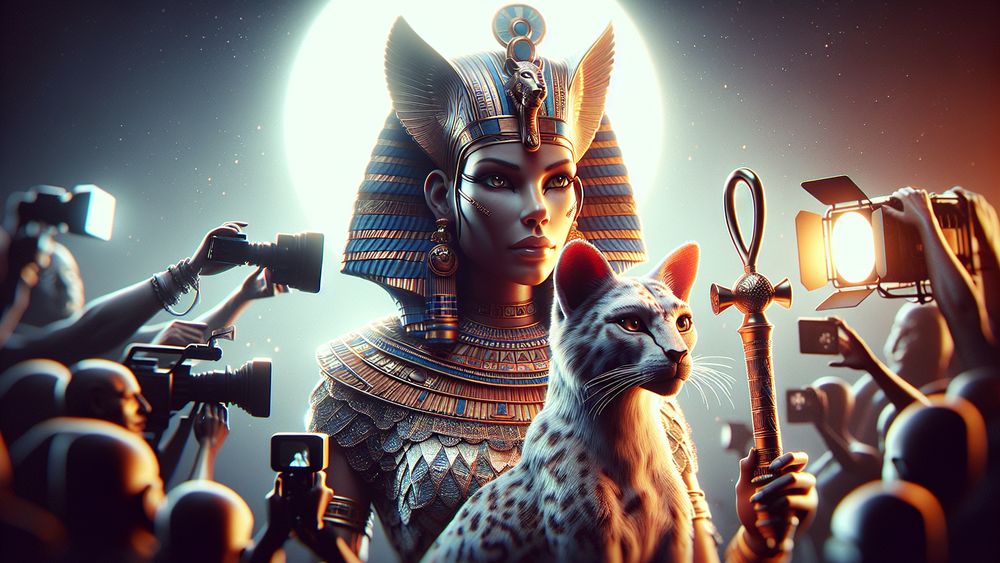
This makes her a very interesting character to watch and learn about. Comics and graphic novels also tell stories about Bastet. They mix old tales with new ways of telling stories. Here, artists draw her in ways that remind us of who she is.
They keep her cat-like qualities and sometimes show her with the sistrum, which is a musical instrument linked to her. Sometimes, music and performances also give a nod to Bastet. They might use cat images or play instruments like the sistrum to honor her.
These performances focus on her being strong and caring at the same time. So, Bastet’s story is still very much alive today. We see her in so many different and creative ways. Each one helps us remember and understand her better.
Bastet’s story remains relevant and alive today through various modern mediums like video games, TV, movies, and comics, which help us understand and remember her as a symbol of strength, care, and protection.
A Glimpse into the Pantheon of Egyptian Mythology
Egyptian mythology is full of gods and goddesses. Each one has a special job and story. This group of deities touches on everything that mattered to the people back then. Life and what comes after it were very big deals.
Gods like Ra, who is all about the sun, and Osiris, who looks after the afterlife, help us see how the Egyptians made sense of the world. Goddesses add more to these stories. Isis is famous for her magic and for being a caring mother. Hathor brings love and beauty into the mix.
Every god and goddess had their own place where people could come and show their respect. They had festivals and special times that brought everyone together. This helped keep peace between the people and these powerful beings. Looking at all these gods and goddesses gives us a clear view into Egypt’s past.
FAQs
1. How did Bastet’s role in Egyptian mythology evolve over time?
Over time, Bastet’s role shifted. She started as a lioness, symbolizing war and protection. Later, she became a domestic cat, focusing on love and fertility. This change mirrors how society’s needs and values transformed.
2. What are the most common symbols and animals linked to Bastet?
When we talk about Bastet, the sistrum and the domestic cat always come up. These are key to her image and how people showed their respect for her.
3. Can you explain the significance of Bastet’s festivals and rituals?
The importance of Bastet’s festivals and rituals shines through in how they celebrate her varied roles and ask for her favor in matters of safety and fertility.
4. How is Bastet represented in today’s culture and media?
In today’s culture and media, Bastet often appears as a symbol of femininity and strength. She features in art, books, and entertainment, drawing on her historical and mythological roots.

